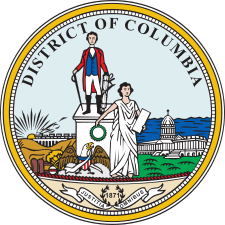Climate change in Washington, D.C.
Climate change in Washington, D.C. is marked by rising temperatures, increased rainfall and flooding, and storm surges of the Potomac River. Tourism is directly impacted as the cherry blossom bloom is shifting. The city's government is active in climate adaptation and mitigation efforts.
Consequences
Rising temperatures
Climate change has already caused a 2 °F temperature rise (compared to 50 years ago) in D.C.[1], warming more than the average nationwide[2]. By the 2080s, the average summer high temperature of the district is expected to increase from the historic high of 87°F to anywhere between 93°F and 97°F.[1] This continues the trend of the District's rising summer temperatures, as five out of six of the District's hottest recorded summers have transpired after 2010.[2] These rising temperatures have an adverse effect on the health of residents, raising the risk of heat-related illnesses, respiratory issues due to increased ozone, pollen, and ragweed counts, and increased disease spread by mosquitoes due to the higher biting rates and faster life cycles caused by rising temperatures.[2]
Summers are 5–10% more humid in 2019 than they were in the 1970s, according to analysis by the Washington Post. This results in up to a 5 degree increase in perceived temperature. Thus an 86 degree summer day, which felt like 89 degrees in the 1970s, may now feel more like 91–92 degrees.[3]
Shifting rainfall
Rainfall is expected to increase during the winter and spring, but remain largely stagnant during fall and summer. This, when combined with increased temperatures drying soil, will increase flooding during winter and spring but increase drought during fall and summer.[2]
Flooding and land subsidence
By 2017, land subsidence was ongoing, nuisance flooding had become more common in the waterfront areas of the city.[4]
Early blooming of cherry blossoms
Washington’s cherry trees are blooming earlier: since 1921, peak bloom dates have shifted earlier by approximately five days.[5][6] The timing of the peak bloom is important to tourism and the local economy because the cherry blossoms draw more than one million people each year, many of whom are visitors.[7]
Climate change mitigation policies
The City of the District of Columbia is implementing a ClimateReady DC plan.[8]
The city has mandated 50% renewable energy by 2032.[9]
Solar Works DC, a program which trains local workers to install residential solar panels, is installing solar on hundreds of homes of low-income residents.[9][10]
References
- Department of Energy and Environment. (year). Climate Ready DC: The District of Columbia's Plan to Adapt to a Changing Climate. (Report No. 123).
- United States Environmental Protection Agency. (2016). What Climate Change Means for the District of Columbia. (Report No. 123).
- Cappucci, Matthew; Samenow, Jason (August 22, 2019). "Climate change has increased humidity in D.C., making it feel even hotter". Washington Post. Retrieved 2019-09-21.
- O'Donnell, Paul (2017-03-07). "Washington Is Sinking, and It's Only Going to Get Worse". Washingtonian. Retrieved 2019-09-21.
- Waxman, Olivia (March 21, 2017). "Springtime's Cherry Blossoms Have a Dark Side". Time. Retrieved 2019-09-21.
- Ashley (July 10, 2019). "Williams". Accuweather. Retrieved 2019-09-21.
- "What Climate Change Means for the District of Columbia" (PDF). United States Environmental Protection Agency. November 2016.
- "Climate Change". District of Columbia Department of Energy & Environment. Retrieved 2019-09-21.
- "Washington D.C. launches new low-income solar & job training program". PV magazine USA. 2017-05-26. Retrieved 2019-09-21.
- Murillo, Mike (2017-07-24). "New DC program puts solar panels on homes of low-income families". WTOP. Retrieved 2019-09-21.
